Menopause marks a transformative and often challenging chapter in a woman’s life, bringing a host of hormonal shifts that can impact physical, emotional, and metabolic well-being. Among the most common and disruptive symptoms reported during this stage are hot flashes—sudden sensations of intense heat, often accompanied by sweating, flushing, and even palpitations. While hormone replacement therapy (HRT) has been a traditional treatment, many women are now seeking natural alternatives. One promising avenue lies in nutrition. Understanding how specific foods influence hormonal balance, inflammation, and thermoregulation can be pivotal. In this comprehensive exploration of the best menopause nutrition strategies, we’ll delve into the 9 foods that fight hot flashes and promote a menopause-friendly diet, offering relief through everyday choices backed by science and tradition.
You may also like: The Ultimate Perimenopause Nutrition Plan for Vital Hormonal Balance and Energy
Understanding the Connection Between Diet and Hot Flashes
The experience of hot flashes is deeply connected to the drop in estrogen levels that occurs during menopause. Estrogen plays a crucial role in regulating body temperature, and its decline can destabilize the hypothalamic thermostat, making the body more prone to sudden bursts of heat. While external factors such as stress, alcohol, and caffeine can exacerbate symptoms, diet emerges as a modifiable factor that can either fuel or calm the body’s internal thermostat.
What makes food such a powerful tool in this transition is its multifaceted impact. Nutrients can influence estrogen metabolism, inflammation, and vascular reactivity—all of which are implicated in hot flashes. Moreover, some foods contain phytoestrogens, plant-based compounds that mimic estrogen in the body and may help bridge the hormonal gap. Others offer cooling properties, stabilize blood sugar, or support liver detoxification, all of which are relevant for managing symptoms holistically. A well-constructed diet for hot flashes does not rely on a single ingredient but instead draws upon a diverse and balanced array of whole foods with synergistic benefits.
In the following sections, we will explore these nine powerful foods in depth, considering their nutritional profiles, mechanisms of action, and practical ways to incorporate them into daily meals. While every woman’s experience is unique, the principles of using food as functional medicine remain universally relevant and empowering.
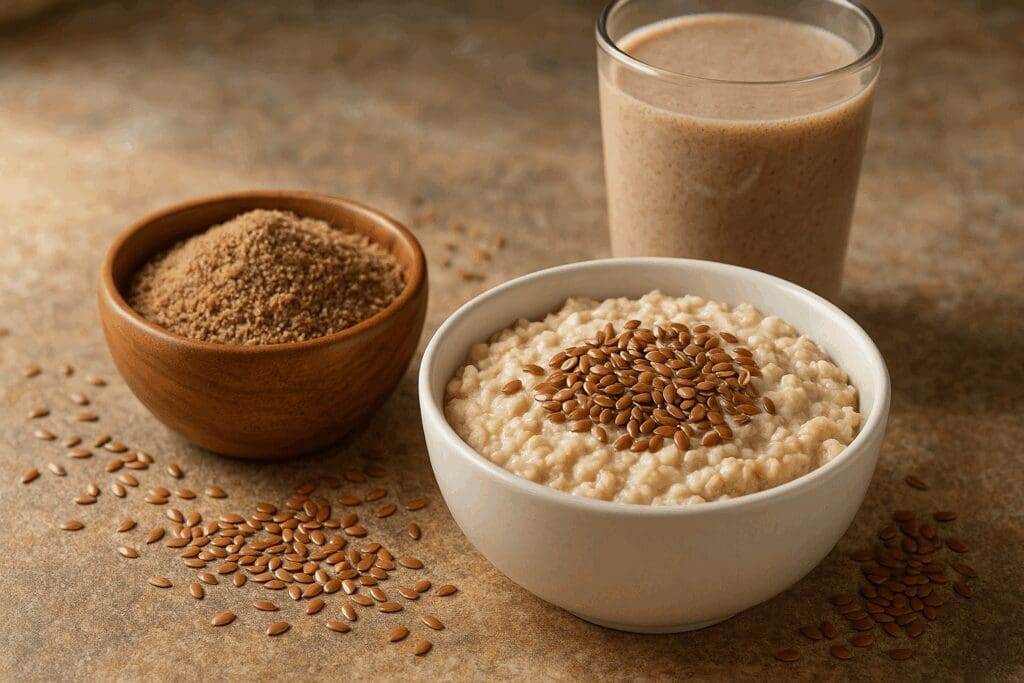
Flaxseeds: A Phytoestrogen-Rich Ally in Hormonal Harmony
Flaxseeds stand as one of the most well-researched and potent plant-based sources of phytoestrogens, specifically lignans, which can provide gentle estrogenic support during menopause. These compounds have a unique ability to bind to estrogen receptors and exert mild estrogen-like effects, potentially easing the hormonal roller coaster that drives hot flashes. Numerous clinical trials have observed reductions in both the frequency and intensity of hot flashes in women who regularly consumed ground flaxseed.
Beyond lignans, flaxseeds are also rich in omega-3 fatty acids, particularly alpha-linolenic acid (ALA), which plays an important role in reducing inflammation. Chronic inflammation is believed to exacerbate menopausal symptoms, so the anti-inflammatory properties of flax can indirectly soothe hot flash episodes. Additionally, flaxseeds support digestive and cardiovascular health—two areas often impacted during and after menopause.
For optimal absorption of lignans, flaxseeds should be consumed ground rather than whole. They can be sprinkled into smoothies, mixed into yogurt or oatmeal, or baked into muffins and breads. A daily serving of one to two tablespoons is generally considered therapeutic. It’s also worth noting that flaxseeds support estrogen metabolism through their fiber content, assisting the liver and gut in properly processing and eliminating excess hormones, which further contributes to hormonal stability.

Soy: The Star Player in Asian Diets That May Curb Hot Flashes
Soy-based foods have long been a dietary staple in East Asian cultures, where the prevalence of hot flashes among menopausal women is significantly lower than in Western populations. This observation has prompted numerous scientific inquiries into soy’s potential as a natural remedy for menopausal symptoms. At the heart of soy’s benefits are isoflavones—compounds like genistein and daidzein that function as phytoestrogens, gently activating estrogen receptors without the risks associated with synthetic hormone therapies.
Clinical trials have shown that regular consumption of soy foods can reduce hot flash frequency by up to 50 percent in some women. While results vary depending on individual genetics and gut microbiota (which affect isoflavone metabolism), the evidence is compelling enough for experts to consider soy a foundational food in any diet for hot flashes. Importantly, whole soy foods—such as tofu, tempeh, edamame, and miso—are preferable to isolated soy protein or supplements, as the synergistic effect of nutrients in whole foods offers broader health benefits.
Besides their hormonal effects, soy foods are high in protein and low in saturated fat, making them ideal for maintaining lean muscle mass and cardiovascular health. These benefits are particularly valuable during menopause, a time when muscle tone and metabolic rate naturally decline. Incorporating one to two servings of soy daily can be both safe and beneficial for most women, provided there are no contraindications such as a history of estrogen-sensitive cancers.
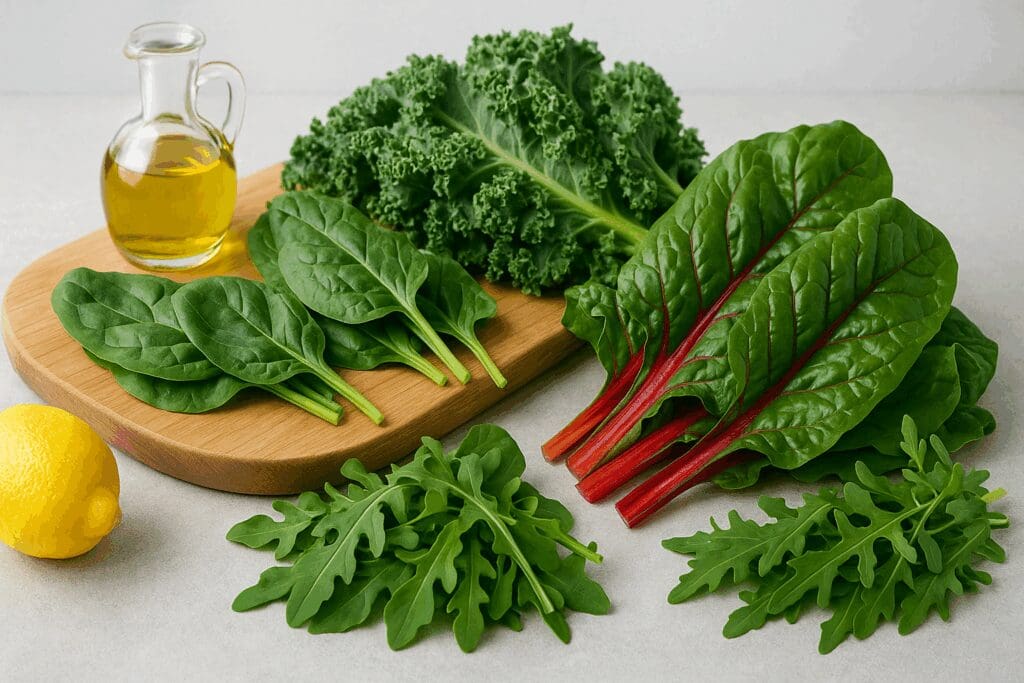
Leafy Greens: Nutrient-Dense Powerhouses That Support Liver Detox and Estrogen Balance
Leafy greens such as kale, spinach, collard greens, arugula, and Swiss chard are nutritional cornerstones of any menopause-friendly diet. Rich in folate, calcium, magnesium, vitamin K, and fiber, these vegetables support multiple systems that intersect with hormonal regulation. One of the key roles leafy greens play in mitigating hot flashes is supporting the liver—a vital organ responsible for metabolizing and eliminating estrogen and other hormones.
When the liver is functioning optimally, estrogen levels remain balanced, which helps prevent the erratic swings that often trigger vasomotor symptoms like hot flashes and night sweats. Leafy greens are high in compounds such as glucosinolates and chlorophyll, which enhance liver detoxification pathways. They also contribute to maintaining healthy blood sugar levels—a crucial factor, as blood sugar spikes and crashes can trigger or intensify hot flashes.
Leafy greens also have a natural cooling effect on the body, rooted in both traditional Chinese medicine and modern nutritional science. Their high water content, alkalizing properties, and rich antioxidant profile help regulate internal heat and inflammation. From a culinary perspective, these vegetables are highly versatile, whether enjoyed raw in salads, sautéed with garlic and olive oil, blended into smoothies, or cooked into soups and stews. Making leafy greens a daily habit can offer compounding benefits over time, addressing not just hot flashes but bone density, cognitive clarity, and cardiovascular resilience as well.
Berries: Antioxidant-Rich Fruits That Cool the Body and Support Vascular Health
Colorful berries—particularly blueberries, strawberries, raspberries, and blackberries—are among the most nutrient-dense and antioxidant-rich fruits available. Their vivid pigments come from anthocyanins, flavonoids that not only protect against oxidative stress but also enhance vascular tone and circulation. Since hot flashes are essentially thermoregulatory events linked to blood vessel reactivity, anything that improves vascular stability can reduce their intensity.
Berries also contribute to hormonal balance through their support of blood sugar regulation. Their natural sweetness is tempered by high fiber content, preventing the sharp insulin spikes associated with refined sugars. Stable blood sugar, in turn, leads to more stable hormone levels, especially during a time when the body is trying to recalibrate without the monthly ebb and flow of estrogen and progesterone.
Another lesser-known benefit of berries is their impact on mood and cognitive function, two areas commonly affected during menopause. Compounds in berries have been shown to modulate neurotransmitters like dopamine and serotonin, offering a natural mood lift. This can be especially helpful for women experiencing emotional volatility or sleep disturbances alongside hot flashes. Berries can be easily incorporated into breakfast dishes, enjoyed as snacks, or blended into functional beverages with flaxseed or soy milk for a therapeutic trifecta.
Avocados: Hormone-Nourishing Fats That Soothe the Nervous System and Stabilize Temperature
Avocados, often heralded as a superfood for their dense nutrient profile, offer a unique combination of monounsaturated fats, fiber, potassium, magnesium, and B vitamins—all of which converge to support hormonal health. In the context of menopause, avocados act as a balm for the nervous system, which is often on high alert due to fluctuating estrogen levels. Calming the nervous system reduces sympathetic overdrive, one of the underlying triggers of hot flashes.
The healthy fats in avocados are particularly valuable because they form the building blocks of sex hormones, including estrogen and progesterone. While the body may not produce significant amounts of these hormones post-menopause, ensuring dietary fat intake remains adequate can support the adrenal glands and other tissues that continue to make small but important amounts. These fats also help regulate satiety and reduce cravings, which can be heightened during hormonal shifts.
In addition to their hormonal benefits, avocados support cardiovascular health and reduce systemic inflammation—two priorities in any diet for hot flashes. Their creamy texture makes them a luxurious addition to meals, whether spread on whole grain toast, added to salads, or blended into smoothies and dressings. Even a few slices per day can contribute to improved thermoregulation, emotional resilience, and skin hydration, another concern during and after the menopausal transition.
Cruciferous Vegetables: Detoxifying Agents That Promote Estrogen Metabolism
Cruciferous vegetables such as broccoli, cauliflower, Brussels sprouts, and cabbage hold a distinguished place in the menopause-supportive nutritional landscape. What sets them apart is their unique content of indole-3-carbinol (I3C) and its derivative, diindolylmethane (DIM)—compounds that facilitate the safe breakdown and clearance of estrogen through the liver. This function is critically important during menopause, when the body must find a new hormonal equilibrium without the cyclical rise and fall of ovarian hormones.
By supporting estrogen metabolism, cruciferous vegetables help prevent the buildup of harmful estrogen metabolites, which can trigger not only hot flashes but also increase the risk of hormone-sensitive conditions. These vegetables also contain sulforaphane, a powerful antioxidant with anti-inflammatory and cancer-protective properties. Inflammation, as previously mentioned, contributes to the frequency and severity of vasomotor symptoms, making anti-inflammatory foods like crucifers doubly beneficial.
From a culinary standpoint, cruciferous vegetables are adaptable to many cooking styles, although lightly steaming them preserves their most delicate compounds. Roasting, stir-frying, or incorporating them into soups and casseroles can also yield delicious and satisfying results. Including at least one serving of cruciferous vegetables daily can serve as a strategic cornerstone in a diet for hot flashes, enhancing hormonal balance, liver function, and immune resilience.
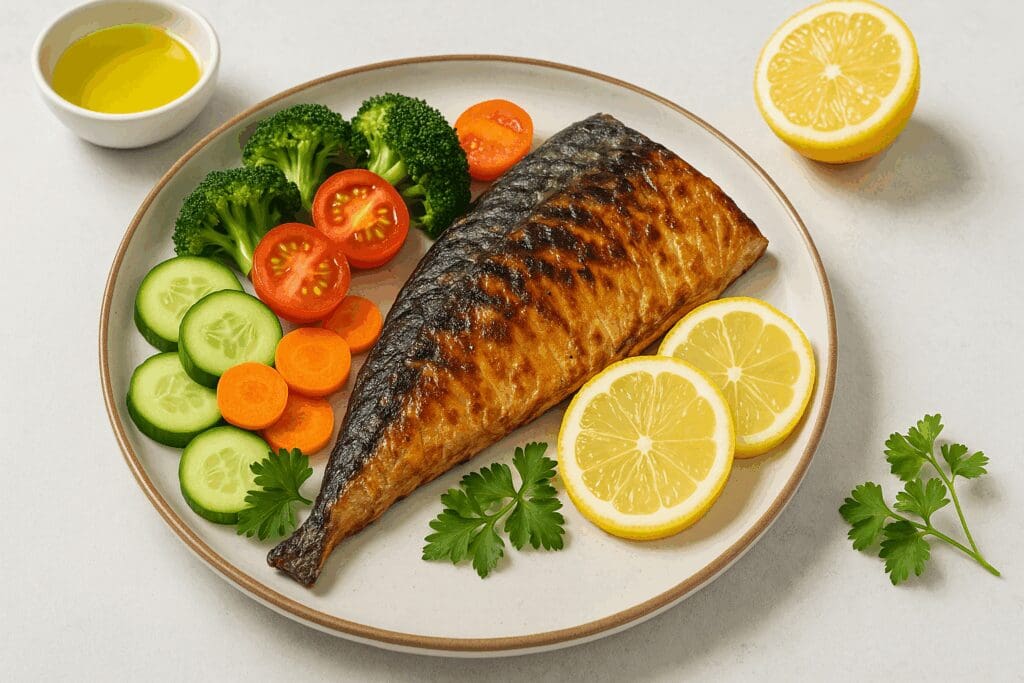
Cold-Water Fish: Omega-3 Powerhouses That Calm Inflammation and Regulate Mood
Cold-water fish such as salmon, mackerel, sardines, and trout are among the richest dietary sources of long-chain omega-3 fatty acids—namely EPA and DHA. These fats are essential for modulating inflammation, maintaining membrane fluidity, and supporting cognitive and cardiovascular health. For menopausal women, omega-3s have been linked with reduced frequency of hot flashes, improved mood stability, and better sleep quality.
The anti-inflammatory properties of omega-3 fatty acids work by inhibiting the production of pro-inflammatory eicosanoids and cytokines. This not only reduces the systemic inflammation that may underlie hot flashes but also supports smoother vascular responses. Omega-3s are also precursors to specialized pro-resolving mediators, molecules that actively bring inflammation to a close—a function that becomes increasingly important with age and hormonal shifts.
Cold-water fish are also an excellent source of protein and vitamin D, both of which are crucial for maintaining bone mass and muscle tone post-menopause. Women who include two to three servings of fatty fish per week often report improvements in not just hot flashes but also joint stiffness, dry skin, and mental fog—all common complaints during the menopausal transition. For those who cannot consume fish due to dietary restrictions, algae-based omega-3 supplements may offer a plant-based alternative with similar benefits.
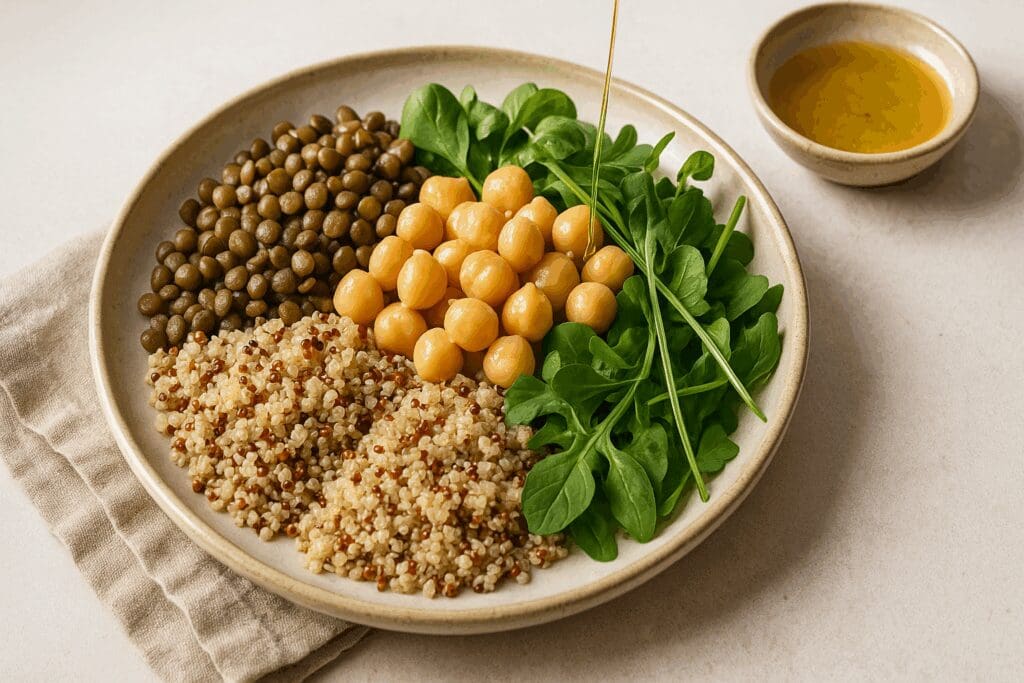
Chickpeas and Legumes: Stabilizing Blood Sugar and Providing Plant-Based Estrogen Support
Legumes such as chickpeas, lentils, black beans, and kidney beans are a nutritional powerhouse, offering a blend of protein, fiber, complex carbohydrates, and phytoestrogens that support metabolic and hormonal balance. Chickpeas, in particular, contain significant amounts of isoflavones—plant compounds with estrogen-like activity that can help moderate hot flash symptoms without the risks associated with hormone therapy.
One of the key advantages of legumes is their ability to stabilize blood sugar levels. By providing slow-burning carbohydrates and ample fiber, they prevent the glucose spikes and crashes that can act as vasomotor triggers. Blood sugar stability also supports more even cortisol and insulin levels, hormones that interact closely with estrogen and influence everything from energy levels to sleep quality.
Legumes are highly adaptable in the kitchen, forming the basis of dishes like hummus, lentil soup, chili, and bean salads. They pair well with grains, vegetables, and healthy fats to create balanced meals that are satisfying and therapeutic. For women exploring a menopause-friendly diet, incorporating legumes at least a few times per week is a practical and affordable strategy for reducing hot flashes and supporting overall vitality.
Whole Grains: Complex Carbohydrates That Regulate Insulin and Reduce Thermal Spikes
Whole grains such as oats, quinoa, brown rice, barley, and bulgur offer slow-digesting carbohydrates that help maintain stable energy and hormone levels throughout the day. Unlike refined carbohydrates, which cause rapid blood sugar fluctuations and contribute to inflammation, whole grains release glucose gradually, avoiding the insulin surges that can disrupt estrogen balance and exacerbate hot flashes.
Beyond their glycemic impact, whole grains are rich in B vitamins, magnesium, and fiber—all nutrients involved in nervous system regulation, adrenal support, and hormonal metabolism. B vitamins, for example, play a critical role in neurotransmitter synthesis and stress response, both of which can influence vasomotor symptoms. Magnesium has been shown to reduce the frequency and severity of hot flashes by promoting relaxation and reducing nerve excitability.
The fiber in whole grains also contributes to estrogen regulation by aiding the elimination of spent hormones via the digestive tract. This prevents estrogen reabsorption and helps keep levels in check. Whole grains are easy to incorporate into meals, whether as a breakfast porridge, lunch grain bowl, or dinner side dish. For a diet for hot flashes to be truly sustainable and effective, whole grains should replace their refined counterparts, offering consistent nourishment that aligns with the body’s changing needs during menopause.

Hydration-Rich Foods and Cooling Herbs: Natural Tools to Reduce Internal Heat
While the focus of this article is on 9 foods that fight hot flashes, it would be remiss not to mention the role of hydration and thermoregulatory herbs in supporting a menopause-friendly diet. Cucumbers, watermelon, celery, and leafy greens are all high in water content, helping to cool the body naturally from within. Adequate hydration not only reduces the sensation of internal heat but also supports the function of sweat glands and detoxification pathways, which can become sluggish during hormonal shifts.
In addition to hydrating foods, herbs like peppermint, sage, and licorice root have long been used in traditional medicine systems to reduce body heat and balance hormones. Sage tea, for instance, has shown promise in small clinical trials for reducing hot flash frequency and severity. Licorice root, which contains compounds with mild estrogenic activity, must be used with caution due to its impact on blood pressure but may offer benefits when taken in appropriate doses under guidance.
Blending these hydrating and cooling elements into the daily diet adds another layer of symptom management. Herbal teas, chilled vegetable soups, and water-rich fruit salads can serve as refreshing options, especially during warmer months or in climates where heat intensifies menopausal symptoms. While not the central players, these elements act as supportive allies in a comprehensive strategy to reduce hot flashes through natural means.
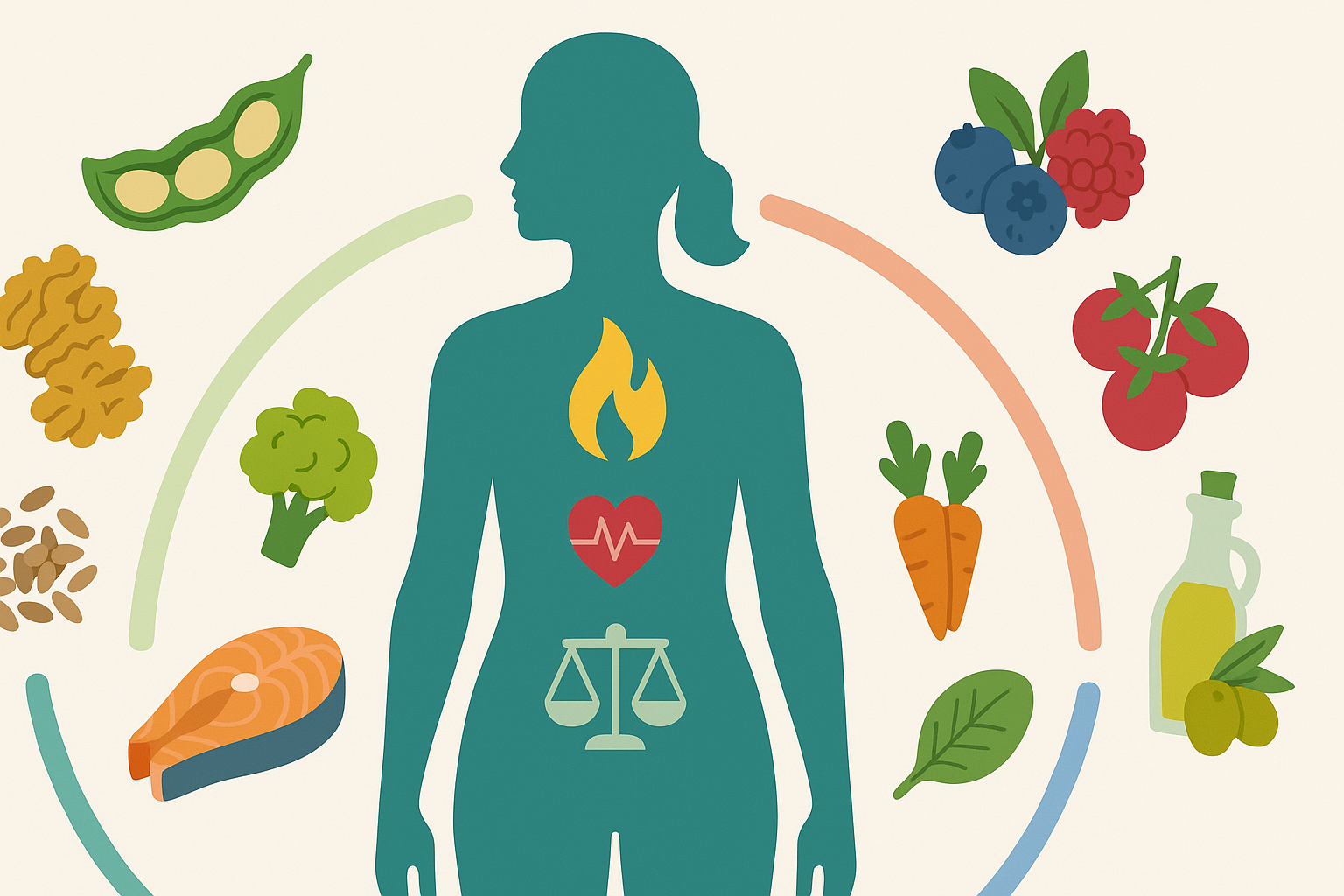
Why These 9 Foods That Fight Hot Flashes Belong in Every Menopause Diet
The cumulative effect of consistently incorporating these 9 foods that fight hot flashes cannot be overstated. Each of these foods offers a unique mechanism—whether it’s phytoestrogens binding to estrogen receptors, anti-inflammatory fats reducing vascular reactivity, or fiber supporting estrogen elimination—that contributes to a broader pattern of hormonal resilience. This synergy becomes more powerful when these foods are combined and consumed regularly rather than in isolation or sporadically.
Moreover, this dietary approach is not just about symptom control. It also fosters long-term health by addressing the cardiovascular, skeletal, cognitive, and metabolic challenges that emerge during the postmenopausal years. Hot flashes may be the most visible or disruptive symptom, but they are rarely isolated from the broader hormonal ecosystem. A diet that emphasizes flaxseeds, soy, leafy greens, berries, avocados, cruciferous vegetables, legumes, cold-water fish, and whole grains addresses these interlocking systems in a unified, sustainable way.
It’s also essential to recognize that this approach empowers women to take an active role in their health. Instead of being passive recipients of medical treatment, women can use their daily food choices to influence how they experience menopause. The foods outlined here are not exotic or difficult to obtain. Most are readily available at local markets and can be prepared in familiar and enjoyable ways. This accessibility reinforces the concept of food as both nourishment and medicine, particularly during times of physiological transition.
A Menopause-Friendly Diet Is About More Than Just Food
While the 9 foods that fight hot flashes form a core part of the strategy, they should be seen within the broader context of lifestyle medicine. Exercise, stress management, sleep hygiene, and social support all play integral roles in how the body experiences hormonal change. For instance, regular physical activity enhances estrogen metabolism, supports weight regulation, and improves mood—all of which impact vasomotor stability. Similarly, mindfulness practices like meditation and deep breathing can reduce the intensity of hot flashes by calming the hypothalamic-pituitary-adrenal (HPA) axis.
Sleep, often disrupted during menopause, is also essential. A well-fed body is better able to regulate melatonin and cortisol rhythms, especially when supported by foods rich in tryptophan, magnesium, and complex carbohydrates. Likewise, building a sense of community and emotional connection can buffer the stress responses that amplify hot flashes. When nutrition is aligned with other pillars of wellness, the entire system becomes more resilient and adaptive.
Thus, the goal is not perfection but integration. A woman may begin by adding ground flaxseed to her smoothie, then discover the benefits of including edamame at lunch, or roasting Brussels sprouts for dinner. Over time, these small shifts add up, creating a dietary pattern that not only reduces hot flashes but supports vitality, clarity, and confidence in the menopausal years and beyond.
Embracing a Long-Term Perspective on Diet for Hot Flashes
It’s important to understand that the effects of diet on hot flashes are often cumulative and may take weeks or even months to fully manifest. Just as hormonal imbalances develop over time, so too does the process of rebalancing through food. Patience and consistency are essential. Women who commit to a nutrient-dense, anti-inflammatory, and phytoestrogen-rich dietary pattern often report not just fewer hot flashes but enhanced skin texture, mood stability, digestion, and overall energy.
Furthermore, personalization is key. While the 9 foods that fight hot flashes offer a strong foundation, individual responses can vary based on genetics, gut microbiota, lifestyle, and medical history. Some women may respond quickly to soy isoflavones, while others benefit more from omega-3-rich fish or magnesium-dense leafy greens. Working with a registered dietitian or integrative physician can help tailor these recommendations to one’s unique needs.
Ultimately, food is not just fuel; it is information for the body. Each meal communicates with our cells, influencing gene expression, hormone production, and metabolic pathways. By choosing foods that support the menopausal transition, women are choosing not just relief from hot flashes, but a roadmap to aging well—with strength, grace, and a sense of agency that transcends biology.
Frequently Asked Questions About Using Diet to Manage Menopausal Symptoms
1. How do cultural food traditions influence the effectiveness of a diet for hot flashes?
Cultural food traditions play a significant role in determining how effectively a person responds to a diet for hot flashes. Traditional Asian and Mediterranean diets, for example, often include naturally estrogenic foods like tofu, lentils, and flaxseeds—key ingredients among the 9 foods that fight hot flashes. These cultures tend to report fewer menopausal symptoms, which may be attributed to long-standing dietary habits. Additionally, preparation methods—like fermenting soy or using olive oil instead of butter—can amplify the benefits of these foods. When crafting a diet for hot flashes, it’s important to consider not just what you eat, but how it aligns with your culinary background and digestion patterns, as cultural familiarity may influence adherence and bioavailability of nutrients.
2. Can intermittent fasting enhance the benefits of the 9 foods that fight hot flashes?
Emerging research suggests that intermittent fasting may amplify the hormonal regulation benefits of the 9 foods that fight hot flashes by improving insulin sensitivity and reducing systemic inflammation. Timing meals to align with circadian rhythms—such as eating during daylight and fasting overnight—may also help regulate cortisol levels, which can indirectly affect the frequency and severity of hot flashes. However, fasting should be approached cautiously, especially for individuals experiencing sleep disturbances or blood sugar fluctuations during menopause. For some, combining a diet for hot flashes with time-restricted eating creates a powerful synergy that supports metabolic health and symptom control. It’s important to work with a dietitian to tailor the approach to your individual needs and medical history.
3. How do environmental toxins impact the effectiveness of a diet for hot flashes?
Environmental toxins—like endocrine-disrupting chemicals found in plastics and certain pesticides—can interfere with estrogen pathways, potentially undermining even the most carefully crafted diet for hot flashes. Phytoestrogen-rich foods such as flaxseeds, chickpeas, and soy are among the 9 foods that fight hot flashes, but their effectiveness may be diminished if the body is already overloaded with xenoestrogens from pollutants. Choosing organic produce, filtering drinking water, and avoiding microwaving food in plastic containers are practical strategies that enhance the efficacy of a hormonal support diet. While dietary intervention is crucial, minimizing exposure to these disruptors is a parallel pillar in a holistic hot flash management plan. It’s not just what you eat—but what you avoid—that counts.
4. How do emotional well-being and stress affect the impact of the 9 foods that fight hot flashes?
Chronic stress raises cortisol levels, which can worsen hot flashes and reduce the body’s ability to process the nutrients found in the 9 foods that fight hot flashes. Even the best diet for hot flashes can fall short if emotional health is neglected. Stress can disrupt digestion, impair nutrient absorption, and increase inflammation—all of which counteract the benefits of anti-inflammatory and phytoestrogenic foods. Integrating stress-reducing practices like mindfulness, yoga, or cognitive behavioral therapy alongside a nutrient-dense diet can significantly improve outcomes. Emotional well-being and dietary choices are deeply interconnected, and addressing both is key for lasting relief.
5. Are there seasonal considerations when selecting foods from the 9 foods that fight hot flashes?
Yes, seasonality matters both in terms of nutrition and sustainability. Many of the 9 foods that fight hot flashes—such as berries, leafy greens, and flaxseeds—can offer enhanced nutritional value when consumed at their seasonal peak. Seasonal foods are often fresher, richer in antioxidants, and more environmentally friendly. For instance, consuming pumpkin seeds in the fall or asparagus in the spring not only diversifies your micronutrient intake but also supports a more intuitive and nature-aligned diet for hot flashes. Seasonal eating also helps prevent dietary fatigue by introducing variety, which improves adherence to long-term nutrition plans for managing menopause.
6. Can the 9 foods that fight hot flashes support gut health, and why does that matter?
Absolutely. Many of the 9 foods that fight hot flashes—such as fermented soy, oats, and legumes—are rich in fiber and prebiotics, which nourish the gut microbiota. A balanced gut biome enhances estrogen metabolism and reduces the reabsorption of hormone byproducts that can trigger hot flashes. Moreover, the gut-brain axis suggests that supporting digestive health may also stabilize mood swings and anxiety, common during menopause. A gut-focused diet for hot flashes provides dual benefits: hormone regulation and emotional resilience. This makes probiotic-rich foods and prebiotic fibers essential tools in managing menopausal symptoms holistically.
7. How do individualized nutrient needs affect the success of a diet for hot flashes?
While the 9 foods that fight hot flashes offer broad benefits, their effectiveness can vary depending on individual nutrient deficiencies or metabolic profiles. For example, women with low magnesium may not respond as well to dietary flaxseed or soy until that deficiency is corrected. Similarly, those with thyroid disorders may need to moderate their intake of certain cruciferous vegetables despite their anti-hot flash properties. A personalized approach—often guided by nutritional testing—helps optimize the diet for hot flashes based on unique hormonal and biochemical needs. This ensures that dietary interventions aren’t just broadly “healthy,” but specifically beneficial to the individual.
8. What is the role of hydration in enhancing the effects of the 9 foods that fight hot flashes?
Hydration plays an underestimated yet crucial role in enhancing the bioavailability and efficacy of the 9 foods that fight hot flashes. Many of these foods, such as legumes and whole grains, are fiber-rich and require adequate fluid intake to support digestion and nutrient absorption. Additionally, dehydration can elevate body temperature and exacerbate the perception of heat during hot flashes. Herbal teas, especially those with natural cooling properties like peppermint or hibiscus, can be excellent additions to a diet for hot flashes. Staying well-hydrated not only boosts metabolic efficiency but also aids in temperature regulation, making dietary strategies more effective.
9. How does alcohol consumption interfere with the benefits of a diet for hot flashes?
Alcohol is a known trigger for hot flashes and can counteract the hormonal-balancing effects of even the best diet for hot flashes. It disrupts liver function, which is critical for estrogen metabolism, and can also increase inflammation and disrupt sleep—two factors that worsen menopausal symptoms. Even moderate consumption may blunt the effects of the 9 foods that fight hot flashes by impairing nutrient absorption or altering blood sugar regulation. Women who reduce or eliminate alcohol often see improved results from their dietary changes. Choosing non-alcoholic alternatives made from hibiscus, cranberry, or other plant-based ingredients can provide hot-flash-fighting polyphenols without the drawbacks.
10. Can meal timing and food pairing enhance the effect of the 9 foods that fight hot flashes?
Yes, strategic food pairing and meal timing can significantly amplify the benefits of the 9 foods that fight hot flashes. Combining phytoestrogen-rich foods with healthy fats—such as pairing flaxseeds with avocado or chickpeas with olive oil—can improve nutrient absorption and hormonal impact. Additionally, consuming complex carbs with protein at dinner may stabilize blood sugar overnight, reducing nighttime hot flashes and improving sleep. Aligning meals with the body’s natural rhythm—such as eating the largest meal mid-day—can also optimize hormone levels. These small, mindful shifts in meal design make the diet for hot flashes not just about what you eat, but also when and how you eat it.
Conclusion: Harnessing the Power of Nutrition to Ease the Menopausal Transition
Navigating menopause can feel overwhelming, but the right foods provide a steady compass. By intentionally incorporating these 9 foods that fight hot flashes into your diet, you are taking proactive, evidence-based steps toward balancing hormones, calming inflammation, and supporting every aspect of midlife health. Whether it’s the phytoestrogens in flax and soy, the cooling antioxidants in berries, or the hormone-nourishing fats in avocado and fish, each food offers a unique layer of support that works in concert with the others.
A menopause-friendly diet is not a rigid prescription but a dynamic, evolving approach that respects the body’s wisdom. It invites women to listen, experiment, and refine their choices based on experience, not dogma. As more research continues to illuminate the connections between nutrition and hormonal health, one truth remains clear: food is one of the most powerful tools we have to manage change.
So as you step into this new chapter, let your plate reflect not just your preferences but your power. Use food to anchor, soothe, and transform—and let your journey through menopause be not just manageable, but meaningful. With every bite of leafy greens, every spoonful of chia and flax, every mindful meal that nourishes instead of depletes, you are writing a new story—one of resilience, self-care, and radiant, enduring health.
Further Reading:
Can Hot Flashes Be Managed Through Diet?



